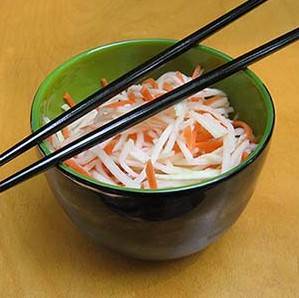 Several years ago I watched two children grab daikon radishes from the crates of the Prairieland Community Supported Agriculture pickup and begin to have a light saber battle that would have made Yoda proud. If only Western adults could muster such enthusiasm for this vegetable.
Several years ago I watched two children grab daikon radishes from the crates of the Prairieland Community Supported Agriculture pickup and begin to have a light saber battle that would have made Yoda proud. If only Western adults could muster such enthusiasm for this vegetable.
Daikon puts Western radishes too shame size-wise. Smaller daikons are eight inches in length, but in loose, loamy soils they can reach nearly double that. And that seems to be the problem for Western consumers who associate size with heat and toughness when it comes to radishes.
However daikons are far milder than their European cousins. In fact they can actually be sweet like turnips which is why they not only make great salads, but soups and stews, as well.
Daikons can be grown in East Central Illinois in the spring and fall. Due to the rain and cold weather (hard to imagine this week I know) the spring crop is just now finding its way into area markets. Daikon’s flavor is best when newly harvested. Though it will store well, the root can take on a stronger, earthier taste, which is why you may want to blanch roots stored for a month or longer before using them in salads or quick pickles.
Using daikon in salads is easy. Simply thinly slice it or grate it. If you have an inexpensive mandolin like a Benriner which is sold at many of the Asian groceries in town, you can make daikon salads in a matter of minutes.
Traditionally the vegetables in the classic daikon and carrot salad are salted, drained, dressed, and chilled, which turns the prep into over an hour. If you can’t spare the time, you can still get the taste, though you will need to serve your salad with a slotted spoon. This is a great accompaniment to take out Chinese when it is too hot to cook.
Quick Daikon Carrot Salad
- 1 8-inch daikon, peeled and finely julienned
- 2 carrots, peeled and finely julienned
- 1/4 c rice wine vinegar
- 2 t sugar
- salt to taste
Combine vegetables. Combine dressing ingredients in a measuring cup. Pour over vegetables.
When the fall daikon crop comes in, you can try it in this stew from my friend, Tuan, who adapted a traditional Vietnamese beef stew recipe, bo kho, with ingredients more common to Western pantries. Tuan’s recipe is very good, good enough that picky eaters in your household may not realize that they are eating daikon instead of potatoes. However, if you have more time and more adventurous eaters in your household, as well as a pantry with Asian staples, sub daikon for the potatoes in a traditional bo kho recipe.
Tuan’s Daikon Stew
- 2 lb. stew beef
- vegetable oil for browning meat
- 2 onions, coarsely chopped
- 5 cloves garlic, minced
- 2 T. vegetable oil
- 2 t. paprika
- 1/ 2 t. ground cinnamon, a rounded 1/2 t. if you like spice
- 2 star anise
- 1 stick cinnamon
- 1/ 4 to 1/ 2 t. cayenne
- 3 T tomato paste
- 1 1/ 2 qts. water.
- 1 piece lemon grass, bruised with the back of a knife, or a 3-inch strip of lemon peel
- 1 large daikon, peeled and cubed
- 5 carrots, peeled and cut into 1 1/ 4-inch pieces
- fresh ground pepper
- 1/ 2 to 1 T. corn starch dissolved in a little water
- 20 – 30 cilantro leaves or more to taste
Brown meat in vegetable oil in batches if necessary. Remove and set aside. Saute onions and garlic in 2 T. oil. Remove from pan. In remaining oil, add spices (except lemon grass or peel, and pepper) and tomato paste. Stir. When spices become fragrant, add 1 1/ 2 quarts water. Add lemongrass/lemon peel and simmer gently for 1 hour. Add vegetables. Simmer 15 minutes more. Add pepper, taste, and adjust seasonings. Skim if necessary. Raise heat to medium. Add starch-water and cook for another 15 to 20 minutes. Stir in cilantro.








